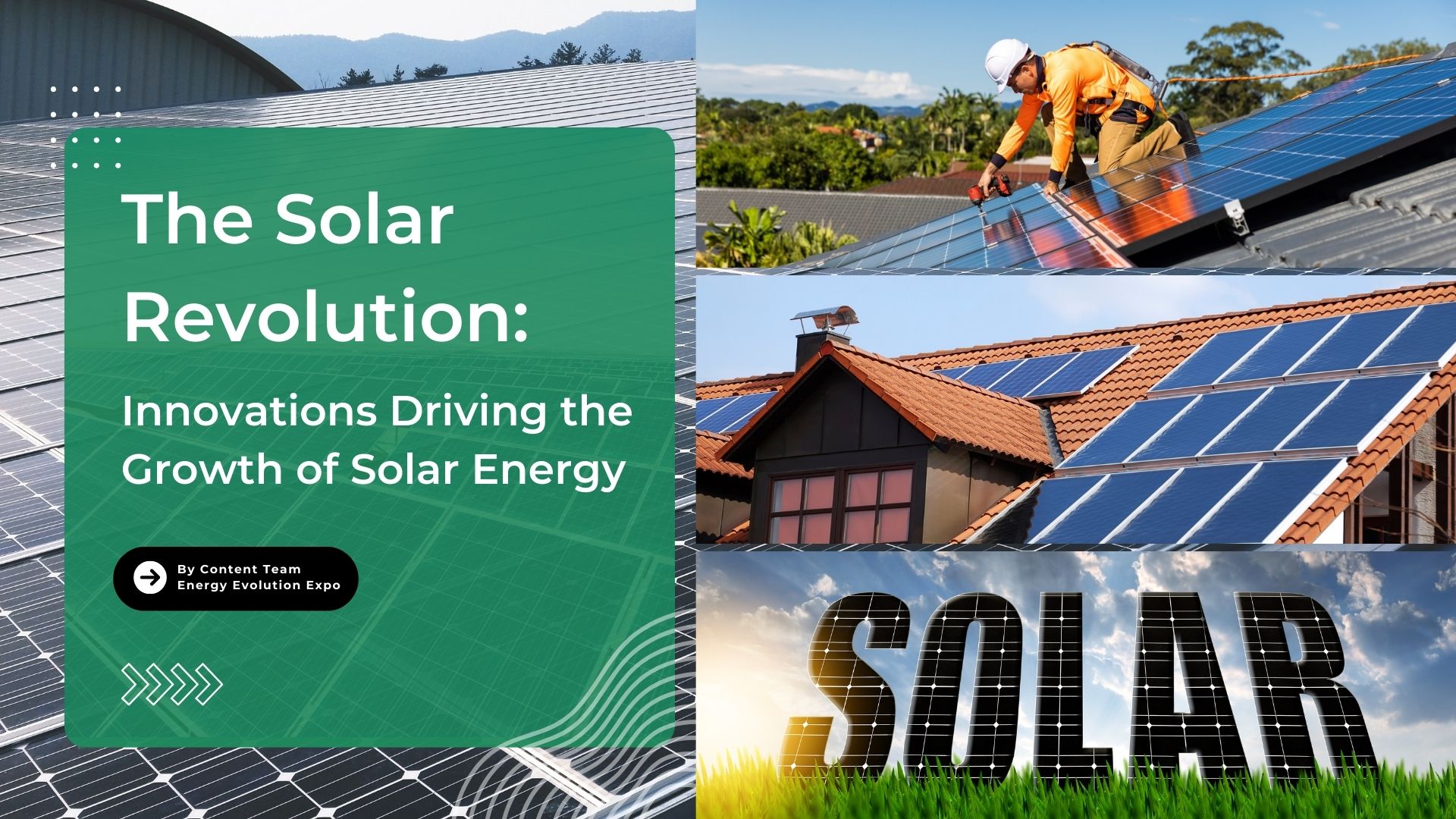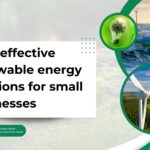The Solar Revolution: Innovations Driving the Growth of Solar Energy

About Solar Energy
The future of solar energy appears promising due to technological advancements and favorable market conditions. These developments offer improved efficiency, reduced costs, and open doors for widespread integration into the global energy sector. The solar energy industry is expected to make substantial advancements thanks to technological innovations and expanding market influences. This discussion will thoroughly examine the future of solar energy, highlighting significant trends and utilizing real-world instances to demonstrate the potential impact of these advancements.

Technological Innovations
1. Advanced Photovoltaic (PV) Cells:
A. Perovskite Solar Cells:
These cells offer high efficiency at lower production costs compared to traditional silicon-based cells. Research and development are making them more stable and commercially viable. For instance, Oxford PV has achieved a record-breaking efficiency of 29.52% with its perovskite-on-silicon tandem cells https://www.oxfordpv.com/perovskite-silicon-tandem-cell
Companies like Rayzon Solar are at the forefront of developing and deploying these advanced cells, which promise to push solar efficiency to new heights (https://rayzonsolar.com/blog/top-solar-technology-trends.html)
B. Bifacial Solar Panels:
These panels can capture sunlight from both sides, significantly increasing energy generation. Applications in places like Dubai’s Mohammed bin Rashid Al Maktoum Solar Park demonstrate their effectiveness, contributing to large-scale solar power projects
2. Energy Storage Solutions
A. Battery Storage Systems:
Innovations in battery technology, particularly lithium-ion and emerging solid-state batteries, are enhancing the ability to store solar energy for use during non-sunny periods. Tesla’s Powerwall is a notable example, enabling homeowners to store excess solar energy.
B. Grid-Scale Storage:
Large-scale storage solutions like the Hornsdale Power Reserve in South Australia are proving crucial for stabilizing the grid and ensuring a reliable supply of renewable energy.
C. Virtual Power Plants:
Virtual Power Plants (VPPs) are increasingly pivotal in managing and optimizing solar energy integration into power grids. Examples include Sunnova’s Project Hestia in the USA, which received a $3 billion loan to expand solar and VPP services to disadvantaged communities, enhancing grid resilience and reducing costs for consumers and utilities In Germany, Next Kraftwerke operates a large VPP connecting thousands of decentralized energy producers, using advanced algorithms to balance supply and demand efficiently. https://www.next-kraftwerke.com/vpp
Sunrun’s 17 MW solar-plus-storage VPP in Puerto Rico aims to improve energy resilience following Hurricane Maria by providing reliable power during outages. https://investors.sunrun.com/news-events/press-releases/detail/275/sunrun-to-build-and-operate-puerto-ricos-first-virtual
These examples illustrate how VPPs integrate distributed resources, enhance grid reliability, and promote sustainability.
3. Smart Grid and IoT Integration
Smart grid innovations are transforming the integration and efficiency of solar energy in modern power systems, ensuring optimal utilization of solar power and contributing to a sustainable and resilient energy infrastructure. Real-life examples include India’s rollout of 250 million smart meters by 2025 as part of a $36.8 billion scheme to enhance grid reliability and efficiency through real-time electricity usage data.
In the USA, New York’s NYSERDA is funding the Future Grid Challenge with $6 million to improve grid stability and data analytics, aiming for a carbon-free electricity sector by 2040. Thailand is upgrading its grid with IoT and semiconductor technologies to handle increased renewable energy and EV demand, targeting a third of its energy from renewables by 2037. Australia’s deployment of Spark Prevention Units and GIS for predictive maintenance enhances grid resilience against natural disasters like bushfires.
In Europe, smart EV charging points co-located with solar generation minimize grid impact by ensuring EVs are charged during peak solar generation hours, reducing overall grid demand and promoting renewable energy use. Companies like SolarEdge are leveraging IoT to enhance the efficiency of their solar products.
4. Off Grid Solar Applications:
Solar-Powered Refrigeration Systems: Innovations in solar-powered refrigeration are vital for preserving food and vaccines in off-grid areas. Companies like Fenice Energy and Koolboks provide solar fridges that ensure consistent cooling without relying on a stable power grid. These systems are especially beneficial in regions with high electricity costs and unreliable grids, aiding in greenhouse gas reduction and public health support.
Off-Grid Solar Kits: Products such as the Renogy 800W 12V Off-Grid Solar Kit offer comprehensive solutions for powering homes and small businesses. These kits, which include high-efficiency solar panels, inverters, and batteries, enable users to generate and store electricity independently from the grid. This is particularly useful in rural areas where grid connection is not feasible.
Solar Water Pumps: Solar-powered water pumps are revolutionizing agriculture in off-grid regions. These pumps provide efficient water use for irrigation, boosting agricultural productivity and sustainability. In India, more than 700,000 solar water pumps are currently in use, reducing dependency on traditional power sources and promoting sustainable farming practices.
Portable Solar Solutions: Companies like Goal Zero and Jackery offer portable solar power stations and panels, ideal for off-grid applications. These portable systems are utilized for camping, emergency backup power, and powering small devices in remote areas, offering a flexible and reliable source of energy wherever needed.
These innovations not only improve energy access but also enhance environmental sustainability and economic development in areas lacking reliable grid infrastructure.
5. Innovations in Solar parks and Solar Farms:
Heterojunction Technology (HJT):
HJT combines crystalline and amorphous silicon layers to achieve efficiencies exceeding 25%. This technology enhances performance in high temperatures and low light conditions, making it suitable for various environments and likely to become a major commercial solar cell type.
TOPCon Technology:
TOPCon (Tunnel Oxide Passivated Contact) solar cells offer efficiencies over 27%, surpassing conventional PERC cells. This technology minimizes recombination losses, ensuring higher energy output and better performance in hot climates, while also being cost-effective to implement due to its compatibility with existing manufacturing processes.
Sun-Tracking Solar Systems:
Solar trackers adjust panel angles to follow the sun, increasing energy production by 20-40% compared to fixed panels. Single-axis and dual-axis trackers optimize energy capture throughout the day, improving overall efficiency and reducing land use for large solar farms.
Applied Examples:
Benban Solar Park, Egypt: Covering 37 square kilometers in Egypt’s Aswan governorate, Benban Solar Park is among the world’s largest solar installations, with a capacity of 1.3 GW. Comprising 27 blocks of 50 MW each, it significantly contributes to Egypt’s renewable energy objectives.
NP Kunta Solar Park, India: Also known as the Anantapur Ultra Mega Solar Park, this facility in Andhra Pradesh currently operates at about 1.2 GW capacity, with plans to expand to 1.5 GW. Spanning 90 square kilometers, it is part of India’s broader strategy to bolster renewable energy capacity.
The Tengger Desert Solar Park: Located in China, this solar park is one of the largest in the world, with a capacity of over 1,500 MW, showcasing the scale at which solar energy can be harnessed.
Floating Solar Farms: Countries like Singapore are exploring floating solar farms to maximize space and reduce water evaporation. The Tengeh Reservoir project is a prime example, providing a substantial amount of clean energy while preserving land resources.
Community Solar Programs: Initiatives like the Solarize programs in the United States allow communities to band together to purchase solar installations at reduced costs, making solar energy more accessible to the public. Community solar programs enable multiple participants within a community to share the benefits of a solar energy system, even if they cannot install panels on their own properties.
Participants typically subscribe to or purchase a portion of the energy generated by a shared solar array, receiving credits or reduced electricity bills in return. These programs promote renewable energy adoption, particularly among renters, low-income households, or those with shaded or unsuitable roofs for solar installations. Additionally, they foster community engagement and support local renewable energy development.
SharedSolar (Minnesota): SharedSolar allows residents, businesses, and organizations to purchase shares of solar energy from community solar gardens. Participants receive credits on their electricity bills for the energy generated by their share of the solar array.
Solarize Portland (Oregon): Solarize Portland is a community-driven initiative that helps residents and businesses in Portland go solar together. Through group purchasing, participants benefit from discounted prices for solar installations and access to local solar contractors.
NY-Sun Community Solar (New York): The NY-Sun Community Solar program in New York State facilitates access to solar energy for residents, businesses, and municipalities. Participants can subscribe to a share of a solar project and receive credits on their electricity bills, supporting the state’s renewable energy goals.
Clean Energy Collective (CEC): Clean Energy Collective operates community solar projects across multiple states in the U.S., including Colorado, Massachusetts, and Minnesota. CEC allows individuals, businesses, and municipalities to subscribe to or purchase shares of solar energy from nearby community solar gardens, providing them with savings on their electricity bills.
Going forward solar energy is marked by significant advancements in solar panel technology, energy storage solutions, and large-scale solar projects. These developments will enhance the efficiency, reliability, and accessibility of solar power, paving the way for a more sustainable and secure energy future. The future of solar energy is bright, with innovations such as perovskite and bifacial solar panels leading the charge, coupled with advanced storage solutions and expanding market reach.
These trends not only reflect technological progress but also a growing commitment to renewable energy across the globe. To facilitate an understanding of the latest developments and trends in the Renewable energy Industry, various Conferences and Expos, which bring the Industry leaders together, are crucial.
The Energy Evolution Awards, Conference, and Expo organized by Next Business Media is making its debut in Spain in 2025. It will be a leading forum dedicated to honoring excellence in Energy Technology, showcasing innovations, and fostering collaborations.
The events unite industry leaders, and visionaries to explore the latest advancements, tackle key challenges, and shape the future of Energy. The Energy Evolution Awards, Conference, and Expo will celebrate outstanding achievements, promote sustainable practices, and drive the Energy Industry forward into a technologically advanced sustainable era. Energy Evolution Awards, Conference, and Expo will be a platform for cultivating innovation and shaping a brighter, more efficient energy landscape.






